Marketing Theory Report: SWOT Analysis of Bec + Bridge Fashion Label
VerifiedAdded on 2022/09/26
|5
|1175
|19
Report
AI Summary
This report analyzes the marketing strategies of the Australian fashion label, Bec + Bridge, founded in 2004. It examines the company's market position in the dynamic textile industry and its brand identity, which focuses on modern, confident women. A SWOT analysis is conducted, highlighting the company's strengths, such as a large target market and sustainable supply chain, and weaknesses, including limited market access and high prices. Opportunities like online market presence and product diversification are explored, along with threats such as stiff competition. The report proposes strategies to exploit opportunities, like collaborating with online platforms and diversifying product lines, and address threats through sustainable manufacturing and marketing practices. The report emphasizes the importance of competitive pricing, a strong local market share, and sustainable marketing practices for long-term success, referencing relevant academic sources.
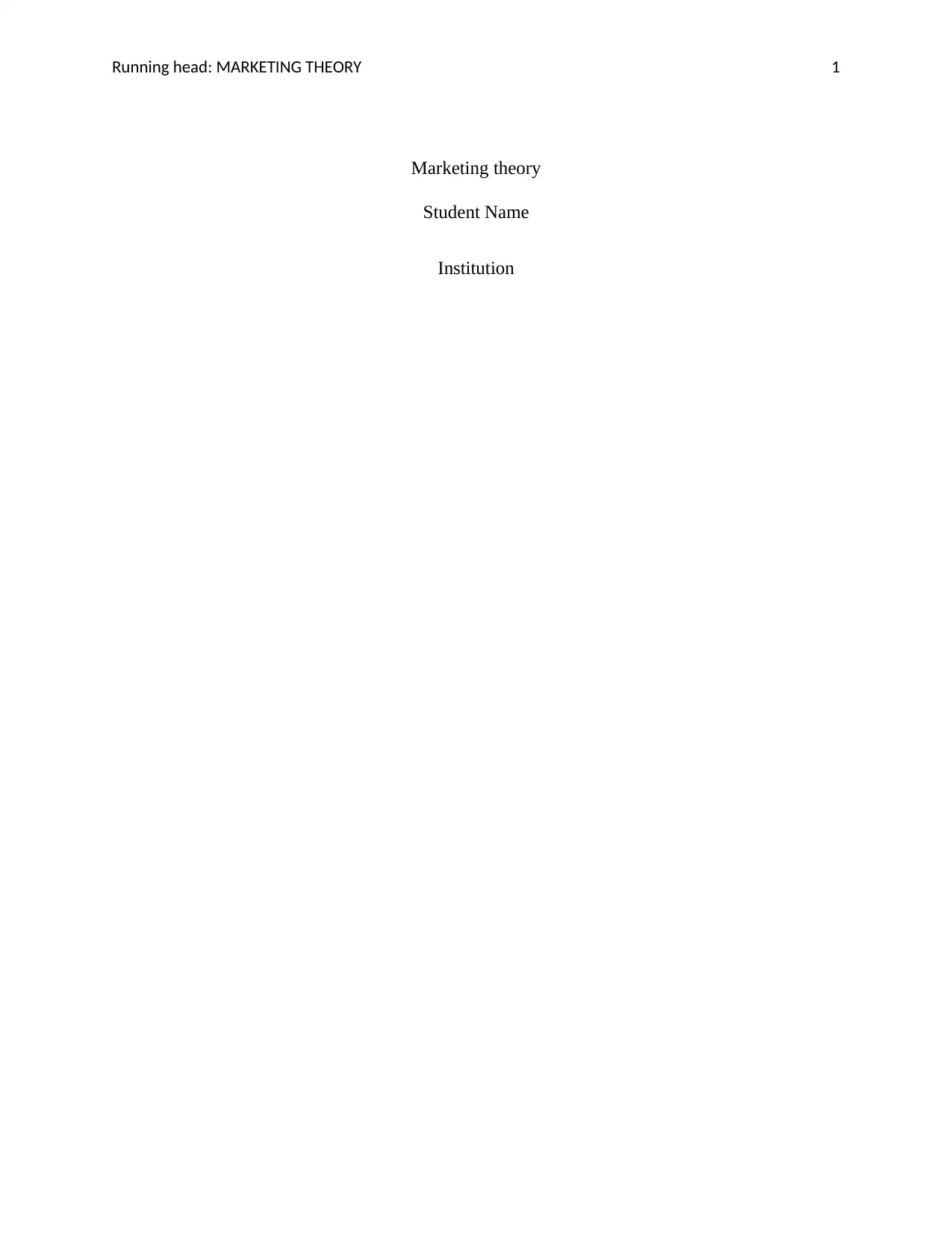
Running head: MARKETING THEORY 1
Marketing theory
Student Name
Institution
Marketing theory
Student Name
Institution
Paraphrase This Document
Need a fresh take? Get an instant paraphrase of this document with our AI Paraphraser
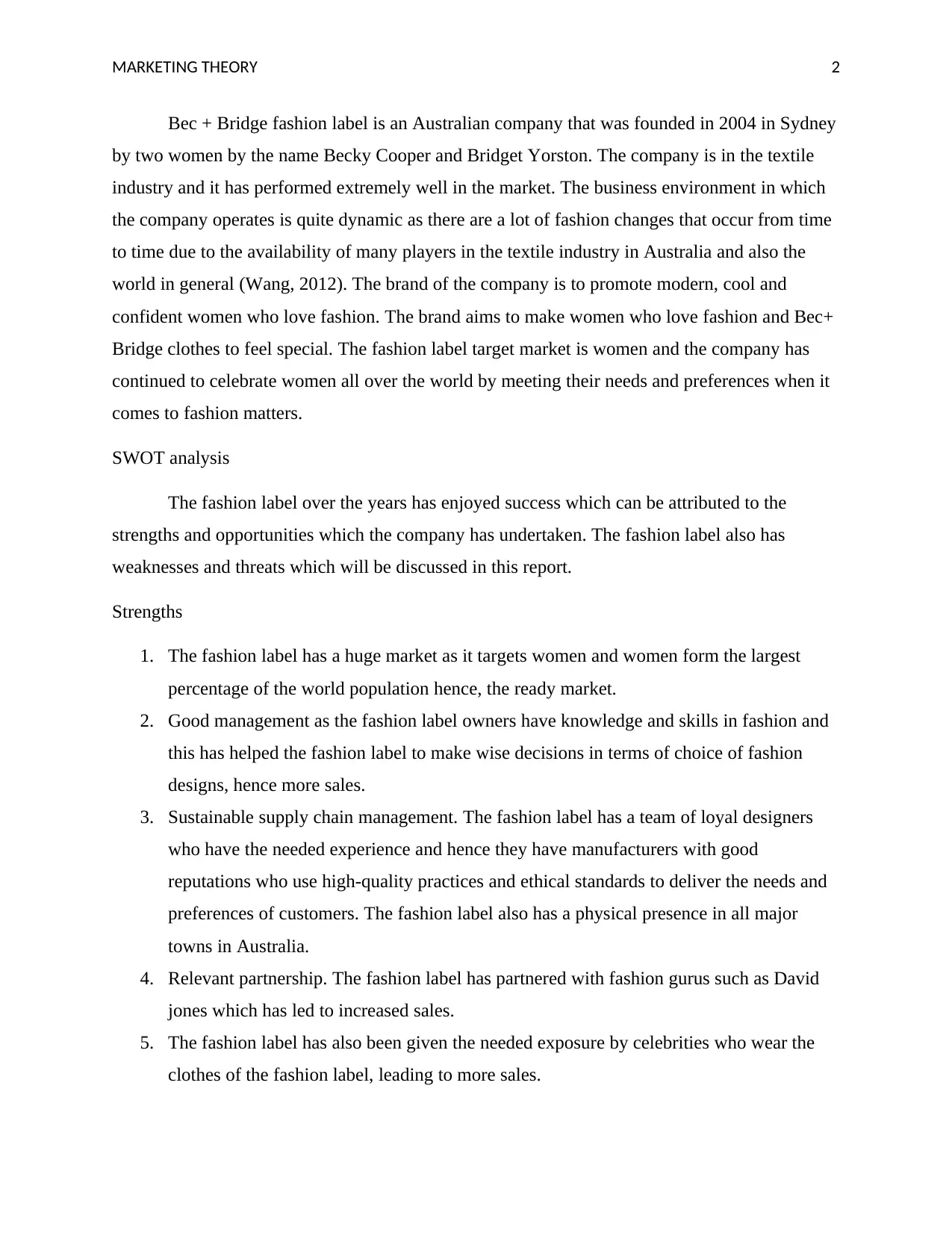
MARKETING THEORY 2
Bec + Bridge fashion label is an Australian company that was founded in 2004 in Sydney
by two women by the name Becky Cooper and Bridget Yorston. The company is in the textile
industry and it has performed extremely well in the market. The business environment in which
the company operates is quite dynamic as there are a lot of fashion changes that occur from time
to time due to the availability of many players in the textile industry in Australia and also the
world in general (Wang, 2012). The brand of the company is to promote modern, cool and
confident women who love fashion. The brand aims to make women who love fashion and Bec+
Bridge clothes to feel special. The fashion label target market is women and the company has
continued to celebrate women all over the world by meeting their needs and preferences when it
comes to fashion matters.
SWOT analysis
The fashion label over the years has enjoyed success which can be attributed to the
strengths and opportunities which the company has undertaken. The fashion label also has
weaknesses and threats which will be discussed in this report.
Strengths
1. The fashion label has a huge market as it targets women and women form the largest
percentage of the world population hence, the ready market.
2. Good management as the fashion label owners have knowledge and skills in fashion and
this has helped the fashion label to make wise decisions in terms of choice of fashion
designs, hence more sales.
3. Sustainable supply chain management. The fashion label has a team of loyal designers
who have the needed experience and hence they have manufacturers with good
reputations who use high-quality practices and ethical standards to deliver the needs and
preferences of customers. The fashion label also has a physical presence in all major
towns in Australia.
4. Relevant partnership. The fashion label has partnered with fashion gurus such as David
jones which has led to increased sales.
5. The fashion label has also been given the needed exposure by celebrities who wear the
clothes of the fashion label, leading to more sales.
Bec + Bridge fashion label is an Australian company that was founded in 2004 in Sydney
by two women by the name Becky Cooper and Bridget Yorston. The company is in the textile
industry and it has performed extremely well in the market. The business environment in which
the company operates is quite dynamic as there are a lot of fashion changes that occur from time
to time due to the availability of many players in the textile industry in Australia and also the
world in general (Wang, 2012). The brand of the company is to promote modern, cool and
confident women who love fashion. The brand aims to make women who love fashion and Bec+
Bridge clothes to feel special. The fashion label target market is women and the company has
continued to celebrate women all over the world by meeting their needs and preferences when it
comes to fashion matters.
SWOT analysis
The fashion label over the years has enjoyed success which can be attributed to the
strengths and opportunities which the company has undertaken. The fashion label also has
weaknesses and threats which will be discussed in this report.
Strengths
1. The fashion label has a huge market as it targets women and women form the largest
percentage of the world population hence, the ready market.
2. Good management as the fashion label owners have knowledge and skills in fashion and
this has helped the fashion label to make wise decisions in terms of choice of fashion
designs, hence more sales.
3. Sustainable supply chain management. The fashion label has a team of loyal designers
who have the needed experience and hence they have manufacturers with good
reputations who use high-quality practices and ethical standards to deliver the needs and
preferences of customers. The fashion label also has a physical presence in all major
towns in Australia.
4. Relevant partnership. The fashion label has partnered with fashion gurus such as David
jones which has led to increased sales.
5. The fashion label has also been given the needed exposure by celebrities who wear the
clothes of the fashion label, leading to more sales.
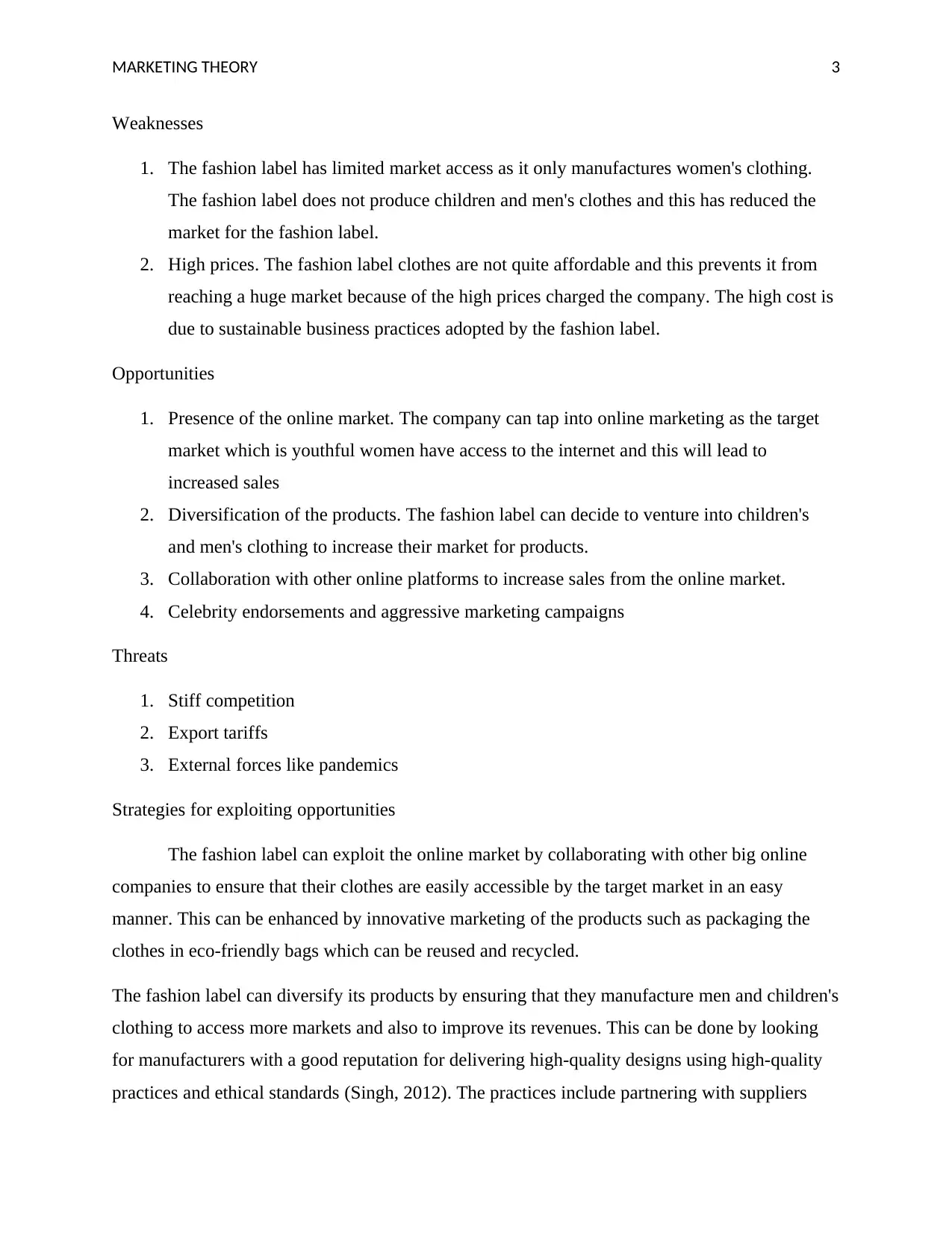
MARKETING THEORY 3
Weaknesses
1. The fashion label has limited market access as it only manufactures women's clothing.
The fashion label does not produce children and men's clothes and this has reduced the
market for the fashion label.
2. High prices. The fashion label clothes are not quite affordable and this prevents it from
reaching a huge market because of the high prices charged the company. The high cost is
due to sustainable business practices adopted by the fashion label.
Opportunities
1. Presence of the online market. The company can tap into online marketing as the target
market which is youthful women have access to the internet and this will lead to
increased sales
2. Diversification of the products. The fashion label can decide to venture into children's
and men's clothing to increase their market for products.
3. Collaboration with other online platforms to increase sales from the online market.
4. Celebrity endorsements and aggressive marketing campaigns
Threats
1. Stiff competition
2. Export tariffs
3. External forces like pandemics
Strategies for exploiting opportunities
The fashion label can exploit the online market by collaborating with other big online
companies to ensure that their clothes are easily accessible by the target market in an easy
manner. This can be enhanced by innovative marketing of the products such as packaging the
clothes in eco-friendly bags which can be reused and recycled.
The fashion label can diversify its products by ensuring that they manufacture men and children's
clothing to access more markets and also to improve its revenues. This can be done by looking
for manufacturers with a good reputation for delivering high-quality designs using high-quality
practices and ethical standards (Singh, 2012). The practices include partnering with suppliers
Weaknesses
1. The fashion label has limited market access as it only manufactures women's clothing.
The fashion label does not produce children and men's clothes and this has reduced the
market for the fashion label.
2. High prices. The fashion label clothes are not quite affordable and this prevents it from
reaching a huge market because of the high prices charged the company. The high cost is
due to sustainable business practices adopted by the fashion label.
Opportunities
1. Presence of the online market. The company can tap into online marketing as the target
market which is youthful women have access to the internet and this will lead to
increased sales
2. Diversification of the products. The fashion label can decide to venture into children's
and men's clothing to increase their market for products.
3. Collaboration with other online platforms to increase sales from the online market.
4. Celebrity endorsements and aggressive marketing campaigns
Threats
1. Stiff competition
2. Export tariffs
3. External forces like pandemics
Strategies for exploiting opportunities
The fashion label can exploit the online market by collaborating with other big online
companies to ensure that their clothes are easily accessible by the target market in an easy
manner. This can be enhanced by innovative marketing of the products such as packaging the
clothes in eco-friendly bags which can be reused and recycled.
The fashion label can diversify its products by ensuring that they manufacture men and children's
clothing to access more markets and also to improve its revenues. This can be done by looking
for manufacturers with a good reputation for delivering high-quality designs using high-quality
practices and ethical standards (Singh, 2012). The practices include partnering with suppliers
⊘ This is a preview!⊘
Do you want full access?
Subscribe today to unlock all pages.

Trusted by 1+ million students worldwide
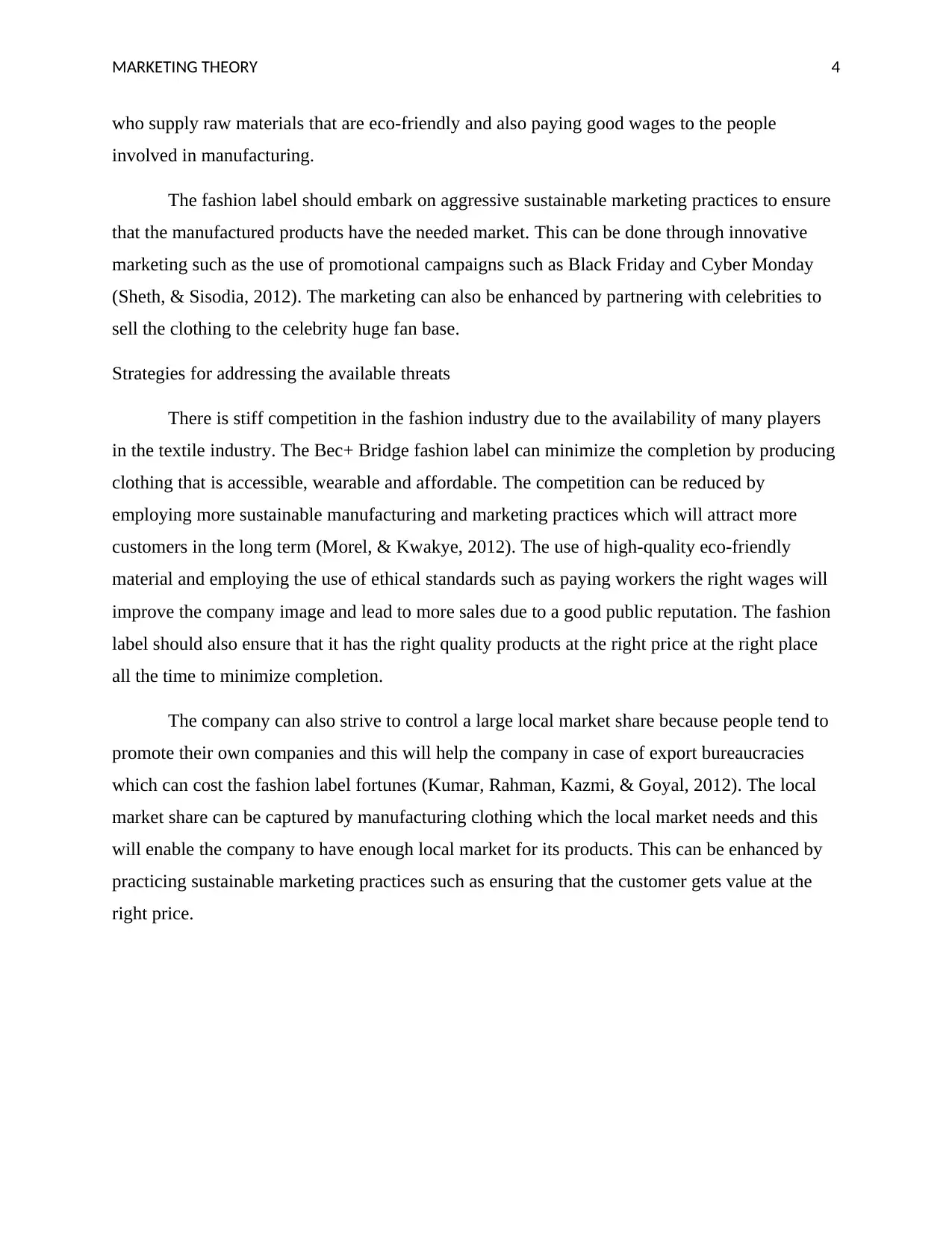
MARKETING THEORY 4
who supply raw materials that are eco-friendly and also paying good wages to the people
involved in manufacturing.
The fashion label should embark on aggressive sustainable marketing practices to ensure
that the manufactured products have the needed market. This can be done through innovative
marketing such as the use of promotional campaigns such as Black Friday and Cyber Monday
(Sheth, & Sisodia, 2012). The marketing can also be enhanced by partnering with celebrities to
sell the clothing to the celebrity huge fan base.
Strategies for addressing the available threats
There is stiff competition in the fashion industry due to the availability of many players
in the textile industry. The Bec+ Bridge fashion label can minimize the completion by producing
clothing that is accessible, wearable and affordable. The competition can be reduced by
employing more sustainable manufacturing and marketing practices which will attract more
customers in the long term (Morel, & Kwakye, 2012). The use of high-quality eco-friendly
material and employing the use of ethical standards such as paying workers the right wages will
improve the company image and lead to more sales due to a good public reputation. The fashion
label should also ensure that it has the right quality products at the right price at the right place
all the time to minimize completion.
The company can also strive to control a large local market share because people tend to
promote their own companies and this will help the company in case of export bureaucracies
which can cost the fashion label fortunes (Kumar, Rahman, Kazmi, & Goyal, 2012). The local
market share can be captured by manufacturing clothing which the local market needs and this
will enable the company to have enough local market for its products. This can be enhanced by
practicing sustainable marketing practices such as ensuring that the customer gets value at the
right price.
who supply raw materials that are eco-friendly and also paying good wages to the people
involved in manufacturing.
The fashion label should embark on aggressive sustainable marketing practices to ensure
that the manufactured products have the needed market. This can be done through innovative
marketing such as the use of promotional campaigns such as Black Friday and Cyber Monday
(Sheth, & Sisodia, 2012). The marketing can also be enhanced by partnering with celebrities to
sell the clothing to the celebrity huge fan base.
Strategies for addressing the available threats
There is stiff competition in the fashion industry due to the availability of many players
in the textile industry. The Bec+ Bridge fashion label can minimize the completion by producing
clothing that is accessible, wearable and affordable. The competition can be reduced by
employing more sustainable manufacturing and marketing practices which will attract more
customers in the long term (Morel, & Kwakye, 2012). The use of high-quality eco-friendly
material and employing the use of ethical standards such as paying workers the right wages will
improve the company image and lead to more sales due to a good public reputation. The fashion
label should also ensure that it has the right quality products at the right price at the right place
all the time to minimize completion.
The company can also strive to control a large local market share because people tend to
promote their own companies and this will help the company in case of export bureaucracies
which can cost the fashion label fortunes (Kumar, Rahman, Kazmi, & Goyal, 2012). The local
market share can be captured by manufacturing clothing which the local market needs and this
will enable the company to have enough local market for its products. This can be enhanced by
practicing sustainable marketing practices such as ensuring that the customer gets value at the
right price.
Paraphrase This Document
Need a fresh take? Get an instant paraphrase of this document with our AI Paraphraser
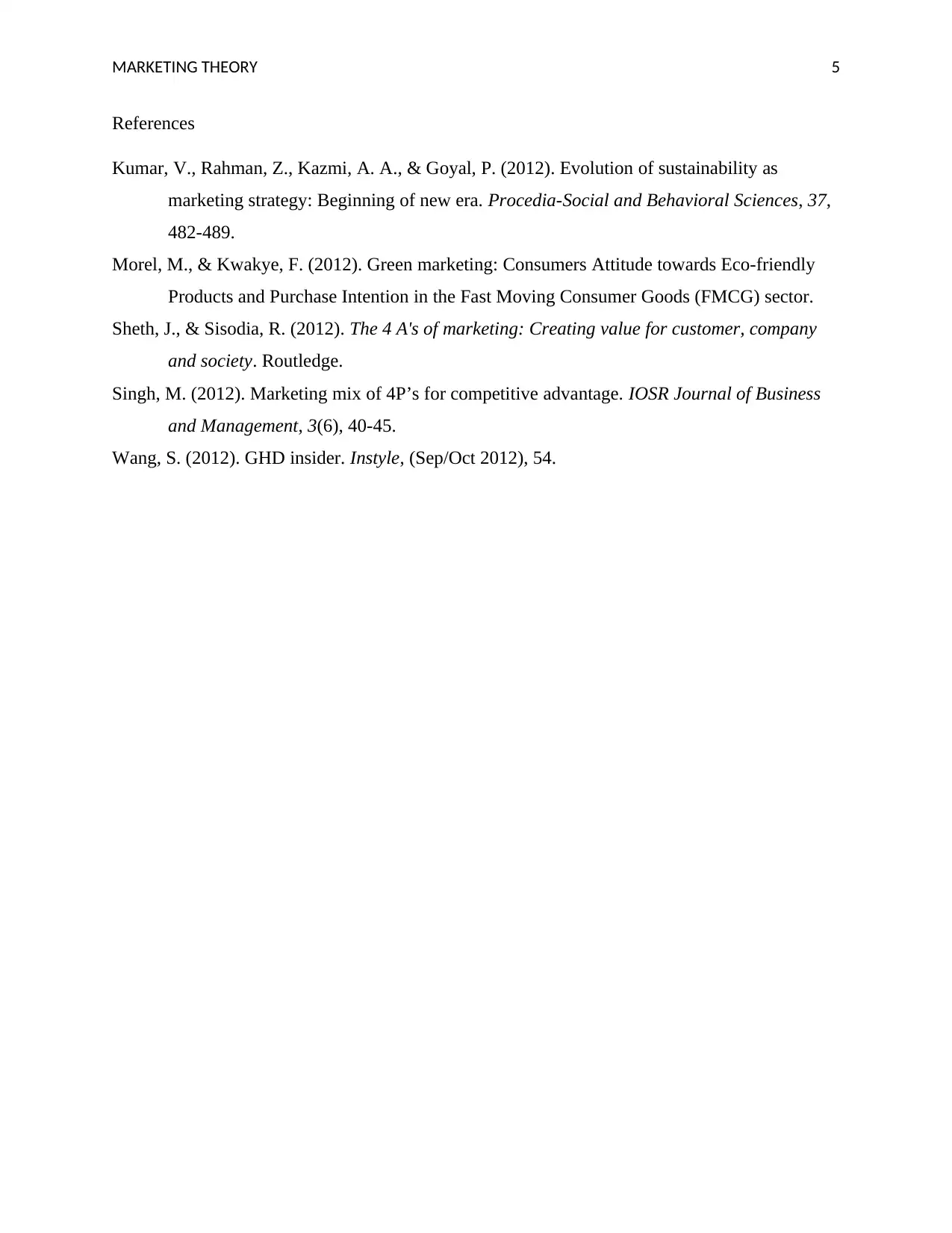
MARKETING THEORY 5
References
Kumar, V., Rahman, Z., Kazmi, A. A., & Goyal, P. (2012). Evolution of sustainability as
marketing strategy: Beginning of new era. Procedia-Social and Behavioral Sciences, 37,
482-489.
Morel, M., & Kwakye, F. (2012). Green marketing: Consumers Attitude towards Eco-friendly
Products and Purchase Intention in the Fast Moving Consumer Goods (FMCG) sector.
Sheth, J., & Sisodia, R. (2012). The 4 A's of marketing: Creating value for customer, company
and society. Routledge.
Singh, M. (2012). Marketing mix of 4P’s for competitive advantage. IOSR Journal of Business
and Management, 3(6), 40-45.
Wang, S. (2012). GHD insider. Instyle, (Sep/Oct 2012), 54.
References
Kumar, V., Rahman, Z., Kazmi, A. A., & Goyal, P. (2012). Evolution of sustainability as
marketing strategy: Beginning of new era. Procedia-Social and Behavioral Sciences, 37,
482-489.
Morel, M., & Kwakye, F. (2012). Green marketing: Consumers Attitude towards Eco-friendly
Products and Purchase Intention in the Fast Moving Consumer Goods (FMCG) sector.
Sheth, J., & Sisodia, R. (2012). The 4 A's of marketing: Creating value for customer, company
and society. Routledge.
Singh, M. (2012). Marketing mix of 4P’s for competitive advantage. IOSR Journal of Business
and Management, 3(6), 40-45.
Wang, S. (2012). GHD insider. Instyle, (Sep/Oct 2012), 54.
1 out of 5
Related Documents
Your All-in-One AI-Powered Toolkit for Academic Success.
+13062052269
info@desklib.com
Available 24*7 on WhatsApp / Email
![[object Object]](/_next/static/media/star-bottom.7253800d.svg)
Unlock your academic potential
Copyright © 2020–2025 A2Z Services. All Rights Reserved. Developed and managed by ZUCOL.




